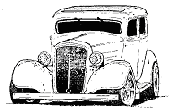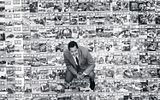Robert E. Petersen ( - 23/03/2007)
Publishing Magnate and Hot Rodder Robert Petersen Lived a High-Octane Life
By Clayton Moore Apr '07
A momentous era in American history loses a little shine with the passing of a true automotive legend. Robert E. Petersen, the publishing, aviation and real estate mogul and generous philanthropist, died on Friday, March 23, at St. John's Hospital in Santa Monica, Calif. Petersen, 80, suffered from back problems in recent years and succumbed to complications from neuroendocrine cancer, against which he fought a brief but intrepid battle.
Petersen's life is a reflection of and a tribute to America's car culture and the audacious spirit of the hot rodders and gearheads of Los Angeles. His fortunes pivoted on his founding of Hot Rod magazine in 1948. His efforts to spread his joy for automobiles led to a hugely successful publishing empire and the creation of the Petersen Automotive Museum in Los Angeles—one of the finest collections of vehicles in the world.
"What made him so special is that he gave every ounce of his energy and abilities to his dreams," said Dick Messner, Petersen Automotive Museum director. "He was a quiet man who truly became an American icon. He made his living doing things he loved and he found success at every turn. The way he lived his life, always looking for ways to give back in return for the success he enjoyed, made you proud to count him as a friend."
Self-education
Robert Einar Petersen was born in East Los Angeles in 1926 but grew up in the California desert. His mother died of tuberculosis when he was 10, leaving the young boy in the care of his Danish immigrant father Einar, a mechanic who worked on heavy equipment for the Los Angeles Department of Water and Power.
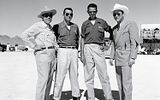
From right: cowboy actor Roy Rogers, National Hot Rod Association founder Wally Parks, Robert E. Petersen and an unknown cowboy enjoy a day at the lakebed races. |
Petersen attended various schools in the desert but dropped out of Barstow High School when he was 15, never to return. He worked as a dishwasher for 25 cents an hour, among other odd jobs, before moving to Los Angeles at age 16.
With a tenacious spirit, Petersen soon landed an $18-per-week job as a messenger boy at MGM, where his job was to plant items about the studio's stars with gossip columnists like Hedda Hopper and Louella Parsons. This job served as Petersen's fast-moving education in the public relations trade. He later worked for promotional wunderkind Earl "Madman" Muntz, an electronics inventor and creative promoter well known in Los Angeles for his peculiar car advertisements.
Petersen enlisted during World War II. Although he hoped he'd be taught to fly, he was assigned as a photographer in an Army Air Corps reconnaissance unit. Having picked up some photography skills, he returned to work briefly for MGM before partnering with other MGM refugees to found Hollywood Publicity Associates, a public relations firm.
Hot Rod's main man
Petersen was looking for clients when he was introduced to Wally Parks, a cofounder of the National Hot Rod Association. They were both enamored with the auto races happening on the dry lake beds of the Mojave Desert and devised a hot rod show to promote them.
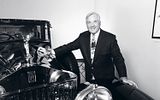
Robert Petersen’s driving passion was for classic automobiles like this Rolls-Royce. He founded the Petersen Automobile Museum in Los Angeles, donating more than $30 million to its construction. |
To drive visitors to the show, Petersen borrowed $400 and started the magazine he straightforwardly dubbed Hot Rod. The first issue, typewritten and resembling a newsletter, debuted in January 1948 with a press run of 5,000 copies. He soon left his PR firm to work fulltime on the magazine, which he hawked at local speedways for 25 cents a copy. "'Hot rod' was a pejorative term in the 1940s," said Ken Gross, automotive historian and former Petersen Automotive Museum director. "Petersen had the vision to see that hot rodding was more than a bunch of kids racing at the dry lakes and on the street." A year later, Petersen launched Motor Trend, a more mainstream publication widely considered one of the most authoritative automotive publications in the country.
He even photographed the magazine's first cover himself. His publishing empire exploded to become the largest niche marketer in the world, publishing a range of magazines devoted to hunting and fishing, motorcycles, skateboarding and teen interests.
Publications such as Guns & Ammo, Hunting, Bowhunting and others reflected Petersen's personal interest in the outdoors. He conducted annual big game safaris, both hunting and photographing animals in Africa and India, until he was sidelined by injuries in 2005. He served as shooting sports commissioner for the 1984 Los Angeles Olympic Games. Petersen also owned one of the world's finest collections of firearms, including a functioning Civil War-era cannon.
Petersen was 37 when he saw an advertisement picturing contestants for "Miss Subway," while on a business trip to New York City. The ad included a particularly attractive girl named Margie McNally. The model and actress, whose trademark was her flaming red hair, accepted the publisher's proposal on their first date. They married in January 1963.
The couple had two sons, but they perished in a small plane crash in the Rocky Mountains in 1975. Robert and Margie Petersen were in one plane and their sons, Bob and Ritchie, were in another. The boys' plane crashed after they encountered bad weather in the mountains. Petersen told the Los Angeles Times in 1995 that he had never recovered from the loss but that it helped him grow as a person.

The Petersen Automotive Museum displays more than 200 classic automobiles and other vehicles. |
He counted many legends among his friends, including automotive legends Carroll Shelby, Wally Parks, George Barris and the late Mickey Thompson. Movie star Steve McQueen would ride up to Petersen's 400-acre ranch near Palmdale, Calif., to race motorcycles with staff from Petersen's magazines.
Peterson's privately held company operated from a 20-story, 200,000-square-foot building on Wilshire Boulevard, across the street from the Hollywood Hyatt Hotel, a popular site with visiting rock stars and other parties. Plenty of intriguing rumors circulated about the nonconformist occupants of both buildings.
Petersen would tell friends that "to limit your interests is to limit your life," and his own business pursuits demonstrated that philosophy. His businesses included a Paso Robles area vineyard; Petersen's Gallery in Beverly Hills, which was home to an important collection of America's western art; and Petersen Properties, a robust real estate development firm. His aviation interest led him to found Petersen Aviation, a fixed base operation, at Van Nuys Airport. In 1994, Forbes Magazine counted him among the country's richest men, with a fortune estimated at $400 million.
Petersen served as chairman of the Petersen Publishing Company for nearly 50 years. By 1996, his publishing company's annual revenue was about $275 million, and Petersen decided to step away from the business. In August of that year, he sold the company to Willis Stein and Partners for $450 million. It was later sold to a London-based conglomerate for an estimated $1 billion. In 2006, the Los Angeles Business Journal speculated that Petersen's fortune had grown to $760 million.
Petersen's legacy
Petersen's collection of automobiles is legendary. He was known to travel in later years in a Bentley Continental GT, but his personal automobiles included a Bugatti Veyron and several Ferraris, including a Superamerica, a F550 Barchetta Pininfarina and a F355 Spyder.
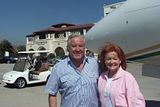
Photo By Bill Stansbeary Robert and Margie Petersen were on hand to greet guests at Airport Journal's Business Aircraft & Jet Preview hosted by Petersen Aviation at Van Nuys Airport. |
One of Robert and Margie Petersen's dreams was to build a proper automobile museum in Los Angeles. On June 11, 1994, they donated $5 million to the Los Angeles County Natural History Museum to build a location to showcase the museum's growing but undisplayed collection of antique and classic vehicles. He chose the site of a former Ohrbach's department store located on a historic commercial stretch of Los Angeles once known as "The Miracle Mile."
Today, the Petersen Automotive Museum, located at the corner of Wilshire Boulevard and Fairfax Avenue, encompasses more than 300,000 square feet. The institution is home to more than 150 classic cars, trucks and motorcycles, as well as innovative dioramas and exhibits designed to portray early Los Angeles. Due to its proximity to Hollywood, the museum also has a fine collection of automobiles owned by movie stars such as Lucille Ball and Frank Sinatra.
"Any car's value is in its provenance," Petersen told Motor Trend last year. "If you have Clark Gable's Caddy, it makes it worth more, plus it's more interesting."
The museum struggled financially in its early days and in 2001, the Petersens donated $28 million to a nonprofit foundation to pay off its debt. The Petersen Automotive Museum Foundation now operates the facility, which draws 175,000 visitors annually.
"It's his legacy to Los Angeles," Messner said. "Mr. Petersen helped create and feed the American obsession with the automobile, delivering gasoline-powered dreams to the mailboxes of millions. He understood the thrill that an average person could get from seeing and reading about horsepower as an art form."
The Petersens supported numerous children's charities and have been major contributors to the Los Angeles Music Center and the Los Angeles County Museum of Art. Petersen was also a founding member of the Thalians social society, which raises money for the Mental Health Center at Cedars-Sinai Medical Center. His philanthropic work earned him special citations from the Los Angeles County Board of Supervisors and the Los Angeles City Council. Petersen served as president and chairman of the board of the Boys & Girls Club of Hollywood and was a member of the national board of directors for the Boys & Girls Club of America. He was also a member of the Los Angeles City Library Commission.
Petersen was to be honored at the Petersen Automotive Museum's annual gala on May 10 with the Icon and Visionary Award. The ceremony, chaired by Carroll Shelby, will now be held as a tribute to the entrepreneur's life
